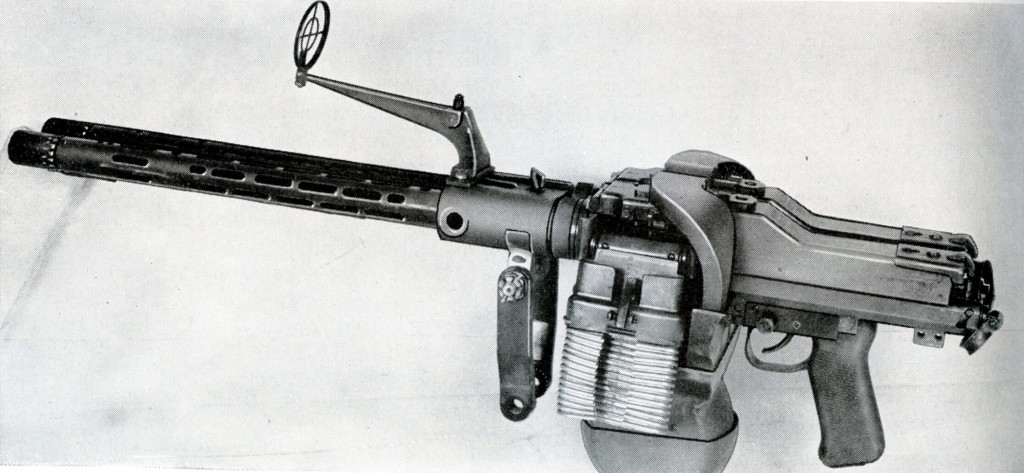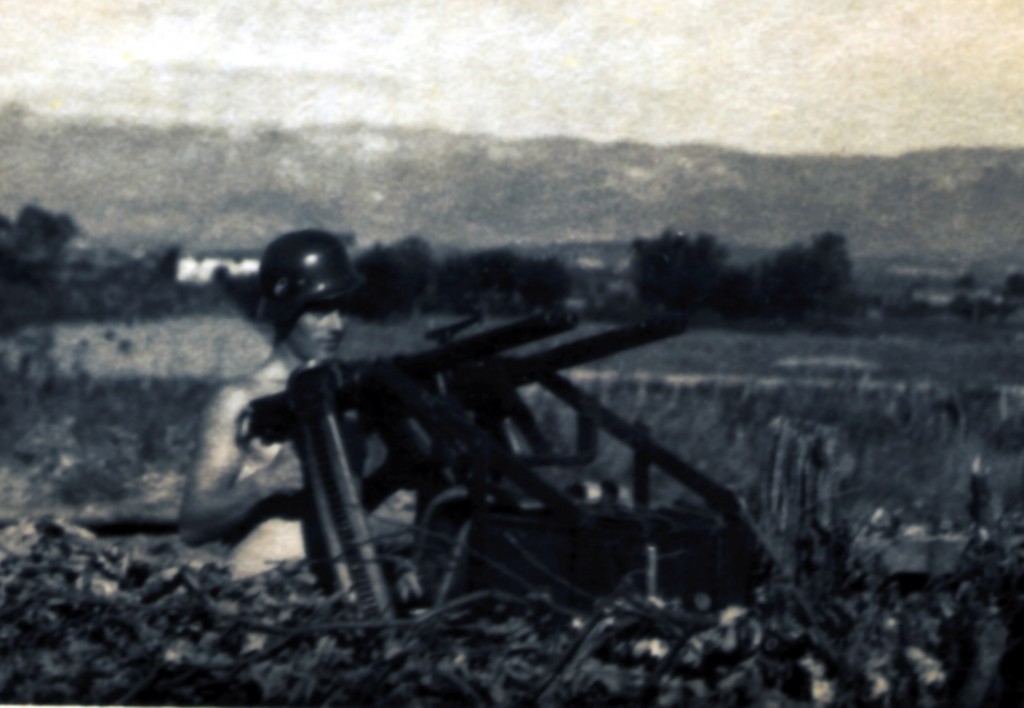by Tom Laemlein
As World War II progressed, the Luftwaffe looked to increase firepower wherever possible, from deploying large-caliber air weapons or increasing the rate of fire with smaller, rifle-caliber weapons. Such is the case with the MG81, chambered in 7.92 x 57mm, belt-fed and firing at up to 1,600 rounds per minute. Mauser designed the MG81 during the late 1930s, and the Luftwaffe first deployed the weapon during 1940. In 1942 the MG81Z (“Zwilling” or twin) entered service. The MG81Z was used as close-range defensive armament for a number of Luftwaffe bombers, including the Do217, He111, He177, Ju88, Ju188 and the last variants of the Ju87 “Stuka”. The MG81Z was also mounted in under-wing canisters (three MG81Z in each canister) on Ju88 and Ju87 to provide maximum ground strafing capability.


Almost simultaneously with the original MG81’s introduction, the Luftwaffe began to move away from rifle-caliber weapons. The extreme rate of fire produced by the twin-barreled MG81Z kept in Luftwaffe service for the most part, but a few of the MG81Zs made it to Luftwaffe field divisions, where some were used in the rare quadruple MG81 (2xMG81Z) anti-aircraft mounts. However you do the math, that is a lot of firepower for use against enemy ground-attack aircraft.
Tom Laemlein runs Armor Plate Press, a military history publishing company that specializes in producing photo studies of 20th Century weapons systems.

What is the weight of the field quadruple 2xMG81Z mount?
Not enough, I’m afraid, to keep that thing in place. It probably has a somewhat slighter recoil push than an M134G, but still would swing substantially in full-auto, I gather. 2x(2×1800) rpm = 7200 rpm, and that’s a real machine gun, not an electric lawn mower like Minigun, so it has some parts reciprocating inside:) I’ve seen once, up-close, effect of a Minigun mount being not tied down/weighted down securely enough. Once – and my curiosity is satisfied forever 😀 Fortunately we all came home not worse for wear that day, but it was a close call.
The Soviets famously developed the Ultra-ShKAS in the late 1930s to improve upon the original ShKAS, which could do “only” 1,800 rpm. The Ultra-ShKAS could do 3,000 rpm, and to my knowledge it’s still the fastest firing single barrel linear action gun ever developed. It wasn’t totally reliable, though, and the Soviets also realized that rifle-caliber machine guns were rapidly becoming obsolete for air combat.
Note that even machine gun firing 7.62x54R with B-32 bullet as fast as 3000rpm will send 9.95g x 3000 = 29850g of bullets, when Berezin machine gun firing 12.7×108 with B-32 bullet and 1050rpm will send 49.5g x 1050 = 51975g of bullets per minute. Not to mention that .30 bullets are far less effective against metal airplanes.
Mentioning multiple barrel small arms, has anyone heard of the SerLea SMG?, It was designed by a Lebanese war veteran for urban warfare. It is chambered in the 9mm Parabellum round and has a unique synchronising device increasing the rate of fire up to 3000rpm. Not much is known of this SMG as some say it was only a blank firing prototype. It did appear in the march 1994 gun world magazine though.
Image:
http://i57.tinypic.com/b8pqok.jpg
The magazine on ebay here:
http://www.ebay.ca/itm/GUN-WORLD-MAGAZINE-MAR-1994-SERLEA-ACE-9MM-DOUBLE-BARREL-SUBGUN-/161276186561
An SMG at 3000 rounds per minute! Even with dual 30 round magazines you would empty the gun in just over a second. You would have to be loaded down like a donkey with spare magazines if you didn’t want to run out after a few blats with it.
I’m feared of recoil of this submachine gun.
The SerLea was almost a reversion to the original concept of the SMG as seen in the Villar Perosa of 1915;
http://www.frontedolomitico.it/Eserciti/Armi/img/singole/VillarPerosa.gif
Of course, the V-P was intended as a flexible gun for aircraft, and then as an LMG;
http://world.guns.ru/userfiles/images/smg/smg127/villar-perosa_1915_3.jpg
In either role, such a high ROF might have some utility, but the weapon would really need a belt feed to be of any real use.
Also, the main interest in SMGs at that time was from law enforcement, which saw 9 x 19mm weapons as having less potential for collateral damage in a SWAT situation.
An SMG spitting out its entire dual magazines’ load before the shooter could let up on the trigger was the absolute last thing they wanted or needed.
cheers
eon
Hi, Eon :
As always, your comments were both informative and interesting. As far as the Villar-Perosa was concerned, it was quite popular with the Alpini ( Italian mountain troops ) because of it’s relatively light weight and ability to put out a large volume of fire in a very short amount of time, and the Alpini also did not seem to mind that it fired the relatively mild 9mm Glisenti pistol cartridge, mainly because of the shorter combat ranges prevalent in the steep mountain terrain they were operating in at the time. Needless to say, the attempts at using the V-P in aircraft applications soon came to naught when it was realized that the Glisenti cartridge was totally inadequate for the exigencies of even the early demands of what was then the new science of aerial warfare. Outside of the Alpini, the V-P was not highly regarded within the more conventionally-oriented regular Italian Army ( it was probably more a victim of existing tactical doctrine than anything else ). Later on, it was found that two perfectly acceptable 9mm SMG’s could be created out of one V-P by simply cutting the latter in half and fitting each half with its own buttstock and dual-trigger mechanism ( one trigger for semi-automatic single shots and the other for full auto, much like the system used in the Beretta M1938 SMG ).
Frankly, I would dearly love to lay my hands on an original twin-barreled V-P or one of the single-barreled SMG derivatives. Has anyone here been fortunate enough to do so? If you have, please share your experiences!
Both are exceedingly rare outside Italy. The OVP SMG was still used in WW2, but from what I’ve read the numbers were quite small, probably in the low thousands at the most. Many of them were probably left in North Africa and either scrapped after the war or rusting away in some corner of Libya or Tunisia. Museum examples of both do exist in Italy.
A side note: the really forgotten and rare Italian WW1 weapon is the Mod. 1918 S.I.A. light machine gun. I have never seen an intact surviving example even in a photograph.
I wonder how much ammo the crew had to hump in to keep that beast fed for more than a few seconds. I can see this as a logistical nightmare for German units on the far end of the supply line. I bet it would be a lot of fun on the firing line at an MG shoot, though. (Except for the cost. 7.92 Mauser isn’t as cheap as it used to be.)
For that kind of application, they would probably have had mechanized ( or at least draught animal-borne ) bulk supplies laid in. I doubt if they would have set it up for relatively small manpacked quantities except in the case of emergency.
Is it just me or is the fellow in the second picture naked?
Does look a bit that way, doesn’t it?
sometimes a hot brass shower is a s clean as you will get.
At least he has his helmet on! All that firepower might get him “excited.”
Stripped to the waist. Common with German troops in hot weather. The photo was probably taken on the Ostfront, at a guess Ukraine or Silesia in summer.
cheers
eon
No, it’s okay, he’s “protected.” Wearing not only a helmet but surely a condom as well.
That quadruple MG81 ( or twin MG81Z, if you prefer ) mount appears to be quite substantial. It is hard to tell from the photo alone what the supporting structure is like below the gunner’s hip level due to the clutter from the surrounding vegetation or camouflage, but I am willing to bet that it is a pretty solid platform, which would make rational sense given the role and mechanical function of the weapon. The Germans would not have gone to all the effort and trouble of coming up with a quadruple mount without first making sure that it could handle the combined recoil of the four guns. If one takes a close look at the well-known quadruple .50-caliber AA mounting used by the U.S. Army for assorted towed and vehicle-mounted applications, one will see that somewhat similar bracing was employed to provide adequate strength — and the quad .50 combination certainly generated a much higher level of recoil energy than the quad MG81 system was ever capable of.
Many thanks to Tom Laemlein and Ian for presenting this article.
The MG81Z was used as close-range defensive armament for a number of Luftwaffe bombers, including the Do217, He111, He177, Ju88, Ju188 and the last variants of the Ju87 “Stuka”
Not to mention the Blohm & Voss BV-38 Flying Wing:
http://fictional-flying-machines.wikia.com/wiki/BV-38_Flying_Wing
Anyone fancy a (deactivated) ground conversion? Found on eGun.de back in 2003.
http://i.imgur.com/PojhWU9.jpg
http://i.imgur.com/70AqZXZ.jpg
http://i.imgur.com/BIt0Yrw.jpg
How much for the deactivated ground gun
920.460.4882
Kind of funny that there is one of these for sale in Florida right now.
No its not mine and I dont know the person selling it. I just seen it on armslist
http://www.armslist.com/posts/3318649/florida-nfa-firearms-for-sale–transferable-mg81z-numbers-match-consecutive-guns–mounts-and-acc-
I have a pair of mg81Z’s as well as a very rare mg81 ground ground I don’t know where to find parts or help restoring mine. can some one please help me 920-460-4882 or email me a vgkauto@yahoo.com
thanks alot
vgkauto@yahoo.com